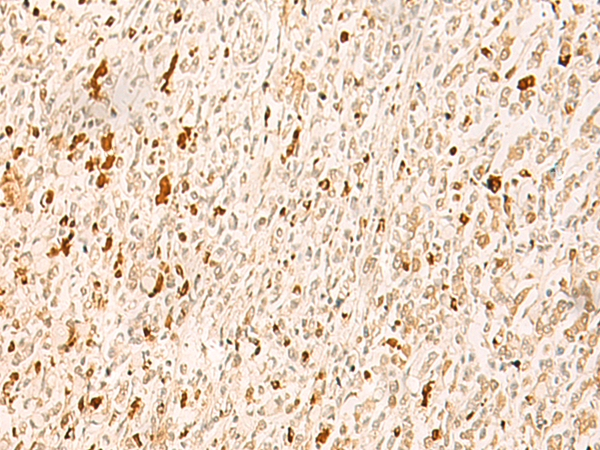


| WB | 咨询技术 | Human,Mouse,Rat |
| IF | 咨询技术 | Human,Mouse,Rat |
| IHC | 1/50-1/300 | Human,Mouse,Rat |
| ICC | 技术咨询 | Human,Mouse,Rat |
| FCM | 咨询技术 | Human,Mouse,Rat |
| Elisa | 1/5000-1/10000 | Human,Mouse,Rat |
| Aliases | TLF; TLP; STUD; TRF2; MGC:8389; MGC:9620 |
| WB Predicted band size | 21 kDa |
| Host/Isotype | Rabbit IgG |
| Antibody Type | Primary antibody |
| Storage | Store at 4°C short term. Aliquot and store at -20°C long term. Avoid freeze/thaw cycles. |
| Species Reactivity | Human, Mouse |
| Immunogen | Fusion protein of human TBPL1 |
| Formulation | Purified antibody in PBS with 0.05% sodium azide and 50% glycerol. |
+ +
以下是3篇关于TBPL1抗体的参考文献及其摘要概括:
1. **文献名称**:*"Tbp-like protein (TBPL1) is required for germ cell development in zebrafish"*
**作者**:Yamaguchi et al.
**摘要**:研究利用斑马鱼模型,通过TBPL1抗体进行免疫沉淀和免疫荧光实验,发现TBPL1在原始生殖细胞迁移和分化中起关键作用,其缺失导致生殖细胞发育异常。
2. **文献名称**:*"The role of TBPL1 in oocyte maturation and early embryonic development in mice"*
**作者**:Lei et al.
**摘要**:通过Western blot和免疫组化分析小鼠卵母细胞,发现TBPL1抗体检测到其在减数分裂中的动态表达,表明TBPL1通过调控特定转录程序支持卵母细胞成熟及早期胚胎发育。
3. **文献名称**:*"TBPL1 as a biomarker for hepatocellular carcinoma progression"*
**作者**:Chen et al.
**摘要**:研究使用TBPL1抗体分析肝癌组织样本,发现TBPL1在肿瘤组织中高表达,并与患者预后不良相关,提示其可能作为肝癌治疗的潜在靶点。
4. **文献名称**:*"Functional divergence of TBP family members in transcriptional regulation"*
**作者**:Gert et al.
**摘要**:通过ChIP-seq和抗体阻断实验,对比TBPL1与TBP的DNA结合特性,揭示TBPL1在胚胎干细胞中调控非经典启动子的转录激活机制。
The TBPL1 antibody is a crucial tool for studying the TATA-binding protein-like 1 (TBPL1), a transcription factor involved in regulating gene expression. TBPL1. also known as TRF3 or TBP2. is a paralog of the TATA-binding protein (TBP) and plays distinct roles in transcriptional initiation, particularly during early development and cellular differentiation. Unlike TBP, which is ubiquitously expressed, TBPL1 is predominantly active in oocytes, early embryos, and certain somatic cells, suggesting specialized regulatory functions in gametogenesis and embryogenesis.
Structurally, TBPL1 shares a conserved DNA-binding domain with TBP but differs in its N-terminal region, which may influence promoter selectivity or interactions with other transcription factors. Research highlights its role in binding TATA-less promoters and facilitating RNA polymerase II recruitment, indicating unique mechanisms in gene activation.
TBPL1 antibodies are widely used in techniques like Western blotting, immunoprecipitation, and immunofluorescence to detect TBPL1 expression, localization, and protein-protein interactions. These studies are vital for unraveling its contributions to developmental processes, such as zygotic genome activation, and its potential dysregulation in reproductive disorders or cancers.
Recent studies also explore TBPL1's evolutionary conservation across vertebrates and its interplay with other transcription regulators, emphasizing its importance in maintaining cellular identity and developmental timing. The availability of specific TBPL1 antibodies continues to advance molecular and developmental biology research, offering insights into transcriptional diversity and disease mechanisms.
×